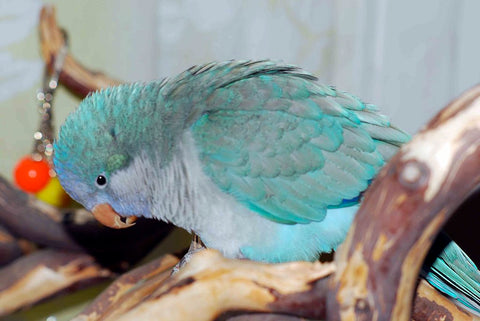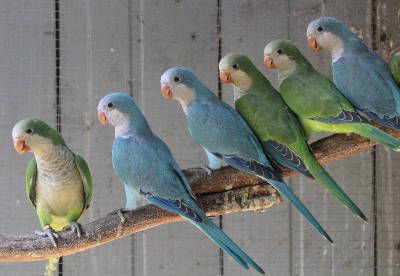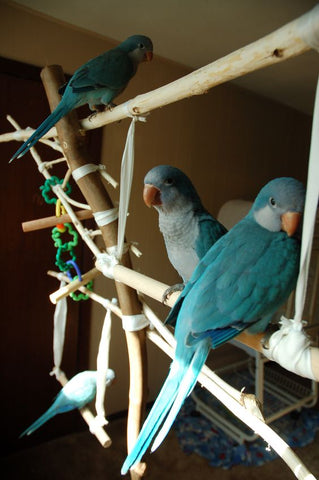Blue Quaker Parrots (Monk Parakeet) Care Guide: Personality, Diet, Lifespan & More

A Blue Quaker Parrot (Blue Monk Parakeet) is a funny and affectionate avian companion just like all Quaker parrots.
Well, except for their obvious color due to years of selective breeding.
For such a small size, the Blue Quaker Parrot packs so much value with its outstanding talking ability, low cost, and availability.
Now, I’m sure you want to know much more about these cute little buggers.
Not to worry.
This guide will reveal all you need to know about Blue Monk Parrots from their origin to their diet and cost to lifespan and everything in between.
[Spoiler Alert] There aren’t any significant differences between Blue and Green Quakers asides color, but I’ll spot where there might be any across the whole article.
Blue Quaker Parrot Aliases
To avoid any confusion and get you acquainted to Blue Quaker Parrots you need to know their other names.
Here are aliases of the Blue Quaker Parrot:
- Blue Quaker Parakeet
- Blue Monk Parrot
- Blue Monk Parakeet
- Blue Parakeet
- Grey-Breasted Parakeet
- Montevideo Parakeet
Blue Quaker Parakeets Bio Data
Generally, wild Monk Parakeets are native to South America in countries like Bolivia, Argentina, Brazil and Paraguay.
Monk Parakeets dwell in the temperate and subtropical regions of these countries. Also, being an open woodland species, they adapt well to urban areas and cold climates.
Consequently, some self-sustaining feral colonies have been introduced into the USA as far north as New York and in some parts of Europe and Asia.
Unfortunately, it is illegal to own or sell a Quaker Parrot in some states because of its potential hazard to locally produced crops in those states (mostly rural). In simple terms, they are considered as major agricultural pests and not pets.

Scientific Information
The Blue Quaker is only a color variation of other Quaker Parrots, and they all have the same scientific name – Myiopsitta Monachus.
The Monk Parakeet has three (3) subspecies:
- M. m. monachus
- M. m. calita
- M. m. cotorra
All the subspecies have distinct color markings, geographical location and size, with M. m. monachus being the largest and most common of them.
Blue Quaker Parakeet Size and Appearance
Blue Quaker Parakeets are relatively small. They are about 11 inches in length from beak to tail.
An adult weighs an average of about 3.5 ounces (100 grams). Most times, they don’t reach this size, not even the slightly larger Green Quakers. But adults in the wild can reach up to 4.4 to 4.9 ounces (127-140 grams).
A Blue Quaker’s plumage is unique and easy to discern from other breeds. It has light blue upperparts (back and wings) stretching to its long tapering tail. Then, it has a bluish-gray breast which is the same tone as its forehead and underwings. Its beak is orange-yellow and has a white eye ring with black eyes.
As a monomorphic species, identification of male and female Quakers can only be done reliably by DNA or feather testing.
However, females tend to be about 10-20% smaller, but you can’t always depend on this for an accurate Quaker gender identification.
Blue Quaker Talking Ability
Blue Quakers are chatterboxes and will learn words within a short time of coming into a new home (a day or two if they are old enough). While they may be unable to assemble an extensive vocabulary like Green Quakers, they can still talk up a storm.
Even better, many of their words are time appropriate which further proves their intelligence and talking ability.
For instance, Smooches, a Green Quaker would say “we go beddie bye” or “can we go to bed” if he’s tired of perching and wants to go into his cage.
The good thing is, Blue Quaker Parrots are also capable of talking in this manner, but with fewer words or phrases:
Noise Level
A Blue Quaker can turn the noise level up at any time he feels like. Typically, he could go at it for a long time making repetitious squawks and shrill screeches.
At least, you’d hope that it ends while he’s feeding, but it doesn’t. Blue Quakers and Quakers, in general, make loudly chatters while feeding.
On the bright side, they tend to make noise only if someone or an animal comes near their cage. This makes your Blue Monk Parrot double as an avian alarm system.
Personality and Behavior Of A Blue Quaker Parrot
The pint-sized Blue Quaker Parrot is comical and has a very large personality for a bird its size. With such a large heart, they are not prone to being a one-person bird and will bond with multiple people if given the opportunity.
This sort of personality makes it a good family pet.
However, if I were you, I’d tread that path with caution. As large as its heart might be, it is also very bold in such a way that it forgets about its small size around larger creatures.
As a result, it can try to impose itself on children or even adults by biting. If you have kids, there are more appropriate parrots you should consider for your home.

Similarly, a Blue Quaker can get very defensive and possessive of its cage and have been known to attack or even kill the intruder. What this means is that you shouldn’t pair your Blue Quaker with another bird unless it’s another Quaker. Even at that, you’ll still need to separate their cages at first to get them to bond.
Unlike other parrot species, Blue Monks will maintain their bond with both their owners and feathered companions.
On the flip side, a Blue Quaker is a playful and energetic bird to keep as an avian companion. For this reason, they need lots of toys in and out of their cage.
Although you need to be prepared to replace chew toys more often, as it can be fairly destructive of them. Then, mix things up with puzzle toys and rotate them regularly, so your feathered friend doesn’t get bored (and they do easily).
If you like, you can bring out the handyman in your Blue Quaker by providing nesting materials in your home.
Proper Care For Your Blue Monk Parakeet and Potential Health Issues
#1 Housing
These birds will live comfortably in a room temperature of 60 to 80 degrees Fahrenheit. In the wild, they are capable of adapting to harsh weather conditions.
A Quaker bird cage should be a minimum of 24x24x24 in size with a ⅝ to ¾ inch bar spacing. But if you can afford to get a larger cage, you should go for the largest available. It will provide enough room for perches and toys to keep your bird limber.
That being said, you need to rotate the toys regularly to keep the bird from getting bored. Boredom can lead to feather plucking and self-harm.
Also, try to install perches of different sizes to keep its feet agile. Installing cement perches can eliminate the need for nail clipping. If the need does arise, I’ll advise you to visit a vet first.

#2 Diet
Quakers need a well-balanced diet that mimics their foods in the wild to stay healthy. These include seeds, fruits, vegetables, insects, nuts and berries.
Oh, and they also love chillies!
It is better to start with pellets for all-around nutrition and mix up with seeds later.
The thing is, seeds and pellets can lead to fatty liver disease and sometimes, make your bird overweight. To avoid this, always supplement your Quaker’s diet with plenty of fresh vegetables.
Check out this list to know the foods that are nutritious and toxic to your Blue Quaker.
#3 Hygiene
It’s pretty much a no brainer. You have to keep your Quaker itself, and its surrounding clean always.
Give her a bath every other day in a shallow basin or misting it with a spray bottle if she’s not entering the bath.
Equally important, clean the cage every day of droppings and leftovers to avoid harmful infections. If you feed your Blue Quaker fresh vegetables, get rid of them after a few hours even if it didn’t take a bite.
#4 Breeding
Blue Quakers are fairly easy to breed and unlike many other parrots, will build their nests. It is recommended you provide nest boxes instead for easy access to the chicks without destroying the structure.
Parents might desert their chicks if you disrupt the nest structure they built.
Their breeding season is between October and December. In a clutch, you can expect around 4-12 eggs with a good chance of all of them hatching in 24 days.
#5 Exercise
As you already know, you need to provide lots of toys to keep your Blue Quaker not only happy but also in shape. A play gym is another way you can help your pet burn off some fat.
How Long Does a Blue Quaker Parrot Live?
A Blue Quaker has an average lifespan of 15 to 25 years. But with proper care, it can live as long as 25 or even 30 years.
How Much Does A Blue Quaker Cost?
A Blue Quaker costs an average of $400 depending on your where you purchase it. The major costs to consider are expenses on maintenance, feeding, and occasional visits to the vet.
Should I Get A Blue Quaker?
If Quakers are allowed in your area, I see no reason why not. Unless you can’t afford to replace their worn out toys or bear the fact they aren’t usually so great with kids.
If not, a Blue Quaker will make a charming avian companion for many years.
